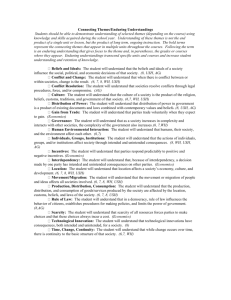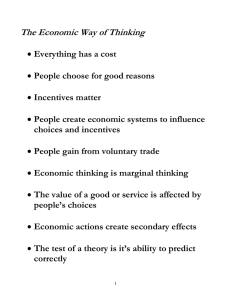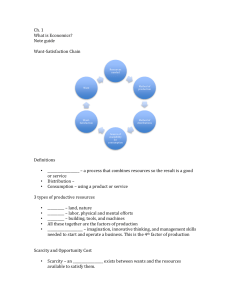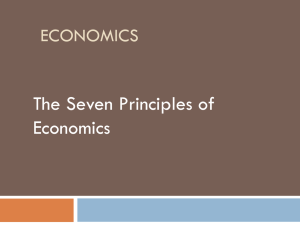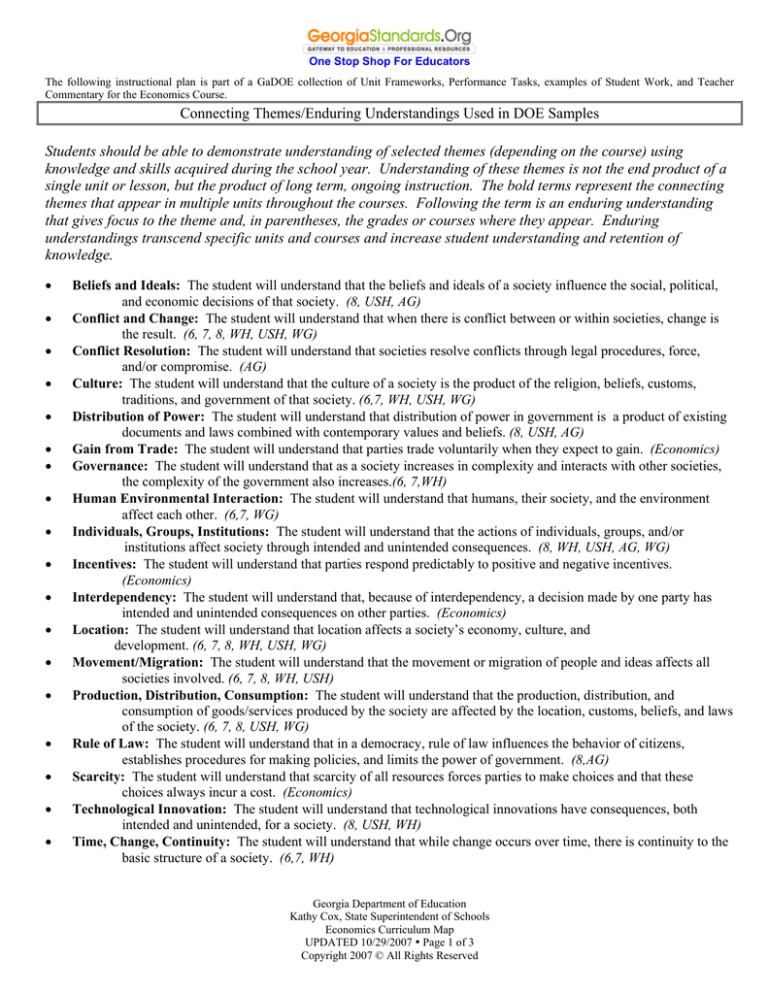
One Stop Shop For Educators
The following instructional plan is part of a GaDOE collection of Unit Frameworks, Performance Tasks, examples of Student Work, and Teacher
Commentary for the Economics Course.
Connecting Themes/Enduring Understandings Used in DOE Samples
Students should be able to demonstrate understanding of selected themes (depending on the course) using
knowledge and skills acquired during the school year. Understanding of these themes is not the end product of a
single unit or lesson, but the product of long term, ongoing instruction. The bold terms represent the connecting
themes that appear in multiple units throughout the courses. Following the term is an enduring understanding
that gives focus to the theme and, in parentheses, the grades or courses where they appear. Enduring
understandings transcend specific units and courses and increase student understanding and retention of
knowledge.
•
•
•
•
•
•
•
•
•
•
•
•
•
•
•
•
•
•
Beliefs and Ideals: The student will understand that the beliefs and ideals of a society influence the social, political,
and economic decisions of that society. (8, USH, AG)
Conflict and Change: The student will understand that when there is conflict between or within societies, change is
the result. (6, 7, 8, WH, USH, WG)
Conflict Resolution: The student will understand that societies resolve conflicts through legal procedures, force,
and/or compromise. (AG)
Culture: The student will understand that the culture of a society is the product of the religion, beliefs, customs,
traditions, and government of that society. (6,7, WH, USH, WG)
Distribution of Power: The student will understand that distribution of power in government is a product of existing
documents and laws combined with contemporary values and beliefs. (8, USH, AG)
Gain from Trade: The student will understand that parties trade voluntarily when they expect to gain. (Economics)
Governance: The student will understand that as a society increases in complexity and interacts with other societies,
the complexity of the government also increases.(6, 7,WH)
Human Environmental Interaction: The student will understand that humans, their society, and the environment
affect each other. (6,7, WG)
Individuals, Groups, Institutions: The student will understand that the actions of individuals, groups, and/or
institutions affect society through intended and unintended consequences. (8, WH, USH, AG, WG)
Incentives: The student will understand that parties respond predictably to positive and negative incentives.
(Economics)
Interdependency: The student will understand that, because of interdependency, a decision made by one party has
intended and unintended consequences on other parties. (Economics)
Location: The student will understand that location affects a society’s economy, culture, and
development. (6, 7, 8, WH, USH, WG)
Movement/Migration: The student will understand that the movement or migration of people and ideas affects all
societies involved. (6, 7, 8, WH, USH)
Production, Distribution, Consumption: The student will understand that the production, distribution, and
consumption of goods/services produced by the society are affected by the location, customs, beliefs, and laws
of the society. (6, 7, 8, USH, WG)
Rule of Law: The student will understand that in a democracy, rule of law influences the behavior of citizens,
establishes procedures for making policies, and limits the power of government. (8,AG)
Scarcity: The student will understand that scarcity of all resources forces parties to make choices and that these
choices always incur a cost. (Economics)
Technological Innovation: The student will understand that technological innovations have consequences, both
intended and unintended, for a society. (8, USH, WH)
Time, Change, Continuity: The student will understand that while change occurs over time, there is continuity to the
basic structure of a society. (6,7, WH)
Georgia Department of Education
Kathy Cox, State Superintendent of Schools
Economics Curriculum Map
UPDATED 10/29/2007 y Page 1 of 3
Copyright 2007 © All Rights Reserved
One Stop Shop For Educators
The following instructional plan is part of a GaDOE collection of Unit Frameworks, Performance Tasks, examples of Student Work, and Teacher Commentary for the Economics Course.
ECONOMICS Course Map
Standards: The focus of this
important first unit is on the concepts
and enduring understandings rather
than specific standards.
•
SSEF1, SSEF2,
SSEF6, SSEPF1
Standards:
SSEF3, SSEMI1,
SSEMI2, SSEMI3,
SSEMI4
Standards:
SSEF4, SSEF5,
SSEMA1, SSEMA2,
SSEMA3, SSEPF3
Standards:
Unit One focus:
Unit Two focus:
Unit Three focus:
Unit Four focus:
Introduction to
Economic Themes
The Choice is
Yours
Markets: Not just
for fleas and stocks
Government and the
Economy: Superhero
or Villain?
GAIN FROM TRADE
Incentives
•
•
INCENTIVES
•
INTERDEPENDENCY
•
SCARCITY
•
•
Reasons to make positive
choices for countries (F6)
Response to incentives (PF1a)
Creating savings/investment
plan (PF1c)
Interdependency
•
Choices made with resources
(F1c, F2a, F6)
Scarcity
•
•
•
•
Definition/use of scarcity
(F1a,d, F2b)
Examples of productive
resources (F1b)
Resources allotment (F6)
Rational Decision making
(PF1b)
Gain From Trade
•
Specialization by businesses and
individuals (EF3a)
•
Desire to trade (EF3b)
•
Circular flow diagram (MI1a)
Incentives
•
Role of money (MI1b)
•
Law of Supply/Demand (MI2a)
•
Role of prices as incentives
(MI2c)
•
Role of profit as incentive (MI4b)
•
Incentives and market structures
(MI4d)
•
Elasticity (MI3c)
Interdependency
•
Relationship of supply/demand
(producers/consumers) in
determining equilibrium (MI2b,c,
MI3a, MI3b,c)
Scarcity
•
Choices made in business
decisions (MI4a,d)
Georgia Department of Education
Kathy Cox, State Superintendent of Schools
Economics Curriculum Map
UPDATED 10/29/2007 y Page 2 of 3
Copyright 2007 © All Rights Reserved
Incentives
•
Taxing decisions (MA3)
•
Tools of the Fed (MA2)
•
Frictional unemployment (MA1d)
Interdependency
•
Government decisions and their
effects (F5, MA2, MA3, PF3)
•
Components of Macroeconomics
(MA1)
•
Fiscal and Monetary Policy
(MA2, MA3))
•
Structural and cyclical
unemployment (MA1d)
•
Business Cycle and relationship
to unemployment (MA1e)
•
Debt/Deficit relationship (MA1f)
Scarcity
•
Ways different economic systems
answer basic econ questions (F4)
•
Government distribution of goods
and services (F5)
•
Decisions in relation to
measuring the economy
(MA1a,b,c)
One Stop Shop For Educators
The following instructional plan is part of a GaDOE collection of Unit Frameworks, Performance Tasks, examples of Student Work, and Teacher Commentary for the Economics Course.
ECONOMICS Course Map
Standards: SSEIN1,
SSEIN2,
SSEIN3
SSEPF2, SSEPF4,
SSEPF5, SSEPF6
Standards:
Unit Five focus:
Unit Six focus:
International Trade
of Mystery
Let’s make it
Personal
Gain From Trade
•
•
Absolute/comparative
advantage (IN1a, b)
Reasons for trade (IN2e)
Incentives
•
•
Arguments for/against free
trade (IN2a, c,e)
Exchange rates (IN3d)
Incentives
•
•
•
•
Importance of investment and
personal interest rates
(PF2a,b,d)
Risk vs. Return (PF2c)
Credit (PF4a,b,c)
Importance of education (PF6)
Interdependency
•
Role of insurance (PF5)
Interdependency
•
•
•
•
Balance of payments/trade
(IN1c)
Trade barriers (IN2a,c)
Trading blocks (IN2d)
Exchange rates (IN3)
Georgia Department of Education
Kathy Cox, State Superintendent of Schools
Economics Curriculum Map
UPDATED 10/29/2007 y Page 3 of 3
Copyright 2007 © All Rights Reserved



